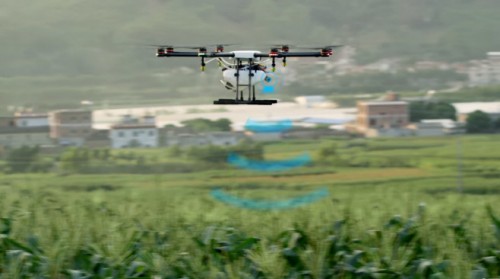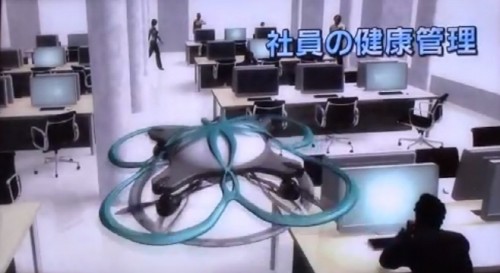 |
| Source: A captured still from DJI's video clip |
By AsiaToday reporter Jisu Kim
As the global drone market is getting more and more intense, Korea, China, and Japan are paving the way for new market by running away from the existing market.
Until now, the drones have been mainly used for aerial photography. However, as the market for drones gradually turned to a red ocean, drone companies are turning their eyes to new markets.
China-based drone maker DJI is focusing on agricultural drones that shoot pesticide instead of photos. Founded in 2016, DJI is leading in the non-military drones. It makes almost two-thirds of the world's civilian drones and its overall revenue reached US$1.5 billion last year. About 75% of its drones are exported mostly to the US and Europe, and they are popular among people who enjoy flying the drones for fun or to take aerial pictures.
Located in the High Tech Park of Shenzhen, China's Silicon Valley, the company's showroom has a variety of drones on display. One side of the showroom shows off the recreational drones like the Phantom series, while the other side boasts the industrial drones for agriculture, public safety, professional photography or film-making. This reflects the company's shift of focus from drones for recreational purposes to drones for more professional uses.
In 2015, DJI launched AGRAS MG-1, an octocopter, or eight-rotor drone which can carry pesticide or fertilizer. The small agricultural drone can carry a liquid payload of 15kg to spray on fields. "DJI sees agriculture as the future for drone business," AFP said on Sunday.
"Within five years, we went from drones that only took photos to machines specialized in first aid or agriculture," said Paul Xu, DJI vice president.
 |
| Source: YouTube |
In Japan, three companies are working together to launch a drone patrol service for offices this year. T-Frend, a drone-based monitoring service, is an ambitious work by Taisei, a Nagoya-based construction company, NTT East, a subsidiary of telecom company NTT, and Tokyo-based drone startup Blue Innovation. According to the Nikkei Asian Review, NTT East will be responsible for the installation of a high-capacity network, Taisei will be handling actual in-office operations, while Blue Innovation will be providing hardware and automatic flight control systems.
Like night guards, the drones they offer will routinely patrol the office after working hours. The recorded video from the night patrol is transmitted to the cloud service provided by NTT East so that building managers can check the image real-time or view recorded video later. The drones have sensors that measure the height from floors and detect obstacles to avoid collisions. They are designed to stay at a certain height to prevents documents from flying due to winds from propellers.
Customers can use these drones to block any internal information leakage that may occur when hiring a third-party security guard. Besides, using drones only after working hours has the advantage of avoiding the fatigue of surveillance that security guards feel when using a CCTV that runs 24 hours a day.
 |
| Source: YouTube video capture (/urobotkaist) |
On the other hand, a rescue drone is being developed in South Korea. Popular Science recently introduced the fireproof spider-man drone made by the Korean Advanced Institute of Science and Technology (KAIST). Named CAROS, for Climbing Aerial Robot System, the rescue drone looks like a normal quadcopter. It can turn perpendicular to the ground and attach itself to surfaces it needs to inspect like Spider-Man. Its sensor can detect information and map 3D environments so it's possible to look inside the building without approaching the building.
"Building inspection is useful, but it's not the most exciting thing a drone can do," said the media. "Fortunately for our short attention spans that crave excitement, CAROS is also going to be a fireproof rescue worker."
"This technology can be used to assess the situation in a fire disaster," KAIST said. "Previously, a mobile robot equipped with a water hose and throwing-type mobile robots were developed to extinguish the fire, but it had a disadvantage when entering and moving through narrow spaces. The CAROS technology can be used as a surveillance robot for use in fires or disasters, as it can pass through narrow indoor environments by changing its mode from wall climbing to flying, and vice-versa, depending on the situation. If CAROS is equipped with a thermal camera, it can detect and track humans through thermal images. In addition, it can transmit environment information by wireless communication."
#Korea #China #Japan #drone #rescue
Copyright by Asiatoday
Most Read
-
1
-
2
-
3
-
4
-
5
-
6
-
7





















